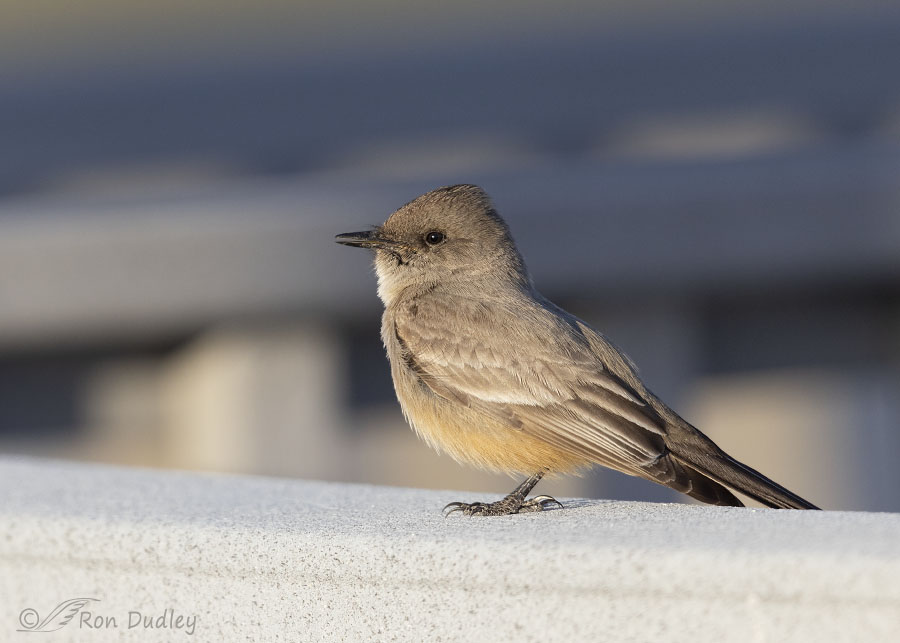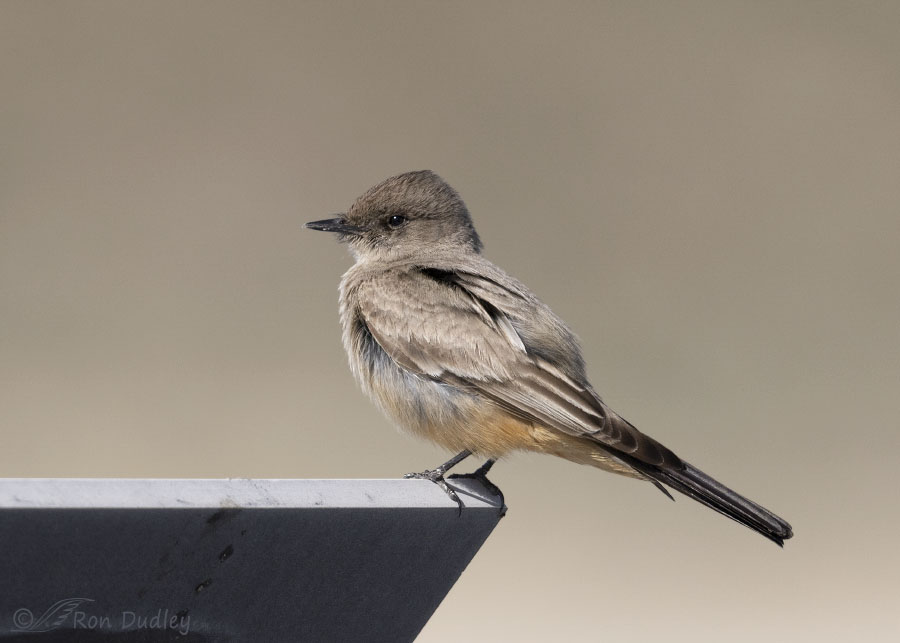He was always on man-made perches but I photographed him so often and he was so persistent I figured he deserved his day in the limelight.

1/2500, f/6.3, ISO 800, Canon R5, Canon EF500mm f/4L IS II USM + 1.4 tc, not baited, set up or called in
I started seeing and hearing this male (based on behavior) Say’s Phoebe soon after the middle of March of this year. I saw him every time I visited the area except one. And without exception he was always calling, persistently and without a break, at least while I was there. This photo was taken on April 7th, but I photographed him many times before and after that date and yes, he was always calling. It tired me out just to watch and listen to him.
Beyond the fact that males arrive on breeding territory before females, little is known about the sexual/breeding behavior of Say’s Phoebes. He was always the only phoebe I saw (or heard) at this location and I had the distinct impression that he was calling to attract a mate. After watching him calling, so many times over that many days, I began to believe his efforts were in vain
Nine days before this photo was taken on March 29, I videoed him while he was calling on one of his favorite perches. That 46 second video can be seen here if you have the inclination. The stiff breeze was blowing my lens around so the video is a little shaky but you’ll definitely see how persistent his singing was.
Imagine keeping that up, hour after hour, day after day.

1/2500, f/6.3, ISO 800, Canon R5, Canon EF500mm f/4L IS II USM + 1.4 tc, not baited, set up or called in
But by four days ago something had changed – he was no longer calling and there were two phoebes hanging around together. This is one of them but I didn’t get any photos of the other one. I’m pretty sure that the phoebes weren’t calling (I didn’t hear a peep out of either one of them) because they had hooked up for the breeding season.
I haven’t seen them since that day. I suspect they’re out making babies.
Ron
Notes:
- It’s possible that he found his mate earlier than I think he did and I just didn’t see her. But given how many times I saw him alone and his change in calling behavior when I saw them together, I doubt it.
- One of my goals during my recovery from anticipated back surgery is to learn how to edit my video clips. Then readers won’t have to suffer through quite so much shakiness and so many video segments that deserve to be edited out.


Wonderful photos. The mockingbird at our condo complex had a mate and a nest in the tree but he still sang and displayed when not collecting bugs and berries and taking them to the nest. Do they mate with more than one female?
The Say’s is a wonderful wintering grasslands bird in my area, and I always look forward to finding them again in the late fall. Whew! I was exhausted just listening to the little guy; he deserves to get the girl! I’m seeing this on a day that I got my own wonderful surprise; a Pacific-slope Flycatcher pair has decided to nest near my kitchen door! I’m not quite sure how that’s going to work out, but Black Phoebes have made it work, so it’s worth a try, I guess.
Persistence!
I wish your flycatchers luck, Nanci. Needless to say, I’m jealous.
Thank you. What a truly delightful lbj – and his call is MUCH, MUCH more pleasant than our persistent songsters.
“his call is MUCH, MUCH more pleasant than our persistent songsters”
EC, I don’t doubt what you say but it always surprises me when you say that. So many of your Australian birds are so colorful I expect them to have lyrical, appealing calls. Illogical of me, I know…
Many of our birds, while beautiful are NOT musical. Unless you consider death metal musical…
Thanks, Ron. This is one of my favorite birds. A pair nested once at my house 25 years ago. As parents, they were exceptionally attentive and dedicated, fledging 3 of 4. Since then, their numbers in town have declined, though this year I’m seeing more than usual in the county. Grant Cty, southern NM.
Kate, I see references saying the life span of Say’s Phoebes in the wild is only about 8-10 years so maybe you were seeing more than one generation?
Beautiful Black Phoebes spend some time in my yards, but don’t believe I’ve ever seen a Say’s here. Love their call, but then I haven’t had to listen to it for more than a few minutes before the bird is off to another location. I thought it sounded like the Western Meadowlark was responding to your Phoebe with words of encouragement: “Don’t worry, she’ll be here soon….” And then she was! I love a happy ending.
Chris, I figured some of my readers would pick up on that singing meadowlark near the beginning of the clip. Maybe the phoebe was trying to outdo it
Persistence is one of your many strong suits, Ron. Your insights into the behavior is certainly another. As usual, I’m grateful for your blog.
Thanks on both counts, Nancy.
The Say’s Phoebe is one of my wife’s and my favorite neighborhood birds. We too would see on our daily morning walk the same individuals singing their hearts out in that sweet plaintive-like call of theirs. Lovely birds. Nice photos.
Michael, I’m surprised this guy didn’t wear his vocal cords (syrinx) out. And I’m not kidding.
I not only enjoyed the video, I’m still poring over the photographs, too.
Your post brought up a great memory of a Say’s Phoebe observation of a few years ago which is very rare here in west-central Florida.
This is such a great time of year and some species like this one sing non-stop until a potential mate shows up. Our backyard crooner is a Northern Mockingbird which we swear must be a recording ’cause nothing could sing all night and all day!
Hope your feeling as well as can be expected today.
Wally, I used to see mockingbirds on Antelope Island regularly this time of year but it’s been several years since I’ve seen any. I miss seeing them and the challenge of trying to photograph their aerial displays.
Great video, Ron. “I’m here”, “I’m here”. So sweet.
Cathryn
Thank you, Cathryn.
I can’t believe this just happened ! I was listening/watching your clip on my
computer–after I turned it off, I could still hear the Phoebe and thought it was
an echo in my imagination; then looked outside my facing window, and there was a Phoebe–calling ! He flew away, but I can still hear him calling from
somewhere across the street ! Has anyone here ever known a bird to respond
to mechanical ( computer ) recording before ?
I loved your story, Kris. Talk about a double-take!
But I’m really not surprised. Birders and photographers use electronic bird calls to attract birds all the time. And no, I’m not fond of the practice.
Using recorded bird calls is a well-known technique for bringing in birds. However, it is considered an unethical practice by most responsible birders, especially during the breeding season. It can cause stress to a bird by looking for an intruder into its territory and it can draw a bird off of the nest. I once refused a request to do a survey for a local Forest Service ranger district. They were searching for two species of warblers, both typically stay high in the conifers. I was to use recording to bring them down then continue the recorded songs for 5 more minutes to see if I could bring more in from neighboring territories. I considered it a totally irresponsible and pointless exercise and strongly advised them against doing this. Such practices may allow you to see a bird better but your first consideration should be to the bird’s well-being.
Exactly, Dan. And in addition to what you said, stressing exhausted migrating birds by calling them in deserves jail time if you ask me.
This guy shows you don’t have to have flashy colors to be appealing, although his vocal displays apparently sealed the deal. I think the camera caught the sound very welll.
Lyle, I’m pretty impressed by how well the camera microphone picks up sounds too – to the point that I have to breathe very slowly and carefully to avoid distracting breathing noises.
He was persistent and it looks like it paid off. We have them in the backyard and I see them often around one of our lakes. Always very active at both locations. They always fly from our fence or from a low perch down to the ground and then back to the perch. One year we the pair had chicks and boy were they cute. I took some photos of them feeding the little guys and gals on our fence.
Good you are getting some photography. I forget whether you said you do have a surgery date?
Nice photo and video.
Thanks, Everett. I’m hoping to have a date for the surgery next week.
Thank you for sharing the video! I have never seen this species up close and enjoyed hearing his call.
I’m glad you enjoyed it, Kellie – amateurish as it is.
For images that sharp I can always ignore a manufactured perch. Don’t think we have those birds here on the east coast but the colouring is very pretty. Or maybe that is just a result of the great light you captured. Hopefully we will all get to see the results of all that singing soon. I don’t get to check in every single day since developing those “header” problems with my phone because I don’t sit with my big computer every day, but, whenever it happens, good luck with that back surgery and a full and speedy recovery.
I appreciate the good wishes, Granny Pat. I just hope all the pieces fall into place, literally and figuratively.
It certainly would get tiresome with all the calling as well a listening to it! Cute little devils!
Cute little devils! 
Ended up with 1.4″ of “water” – most we’ve had at one shot in several year! Snow all gone down here and ground took most of it. YES!
That’s a good storm, Judy! I’m very happy for you. And for all the other farmers and ranchers. I’ll have to look and see how much they got in CB. If any.
While “calling for her” he was craning his neck all over the place! Enjoyed the video.
Good. Thanks, Terri.